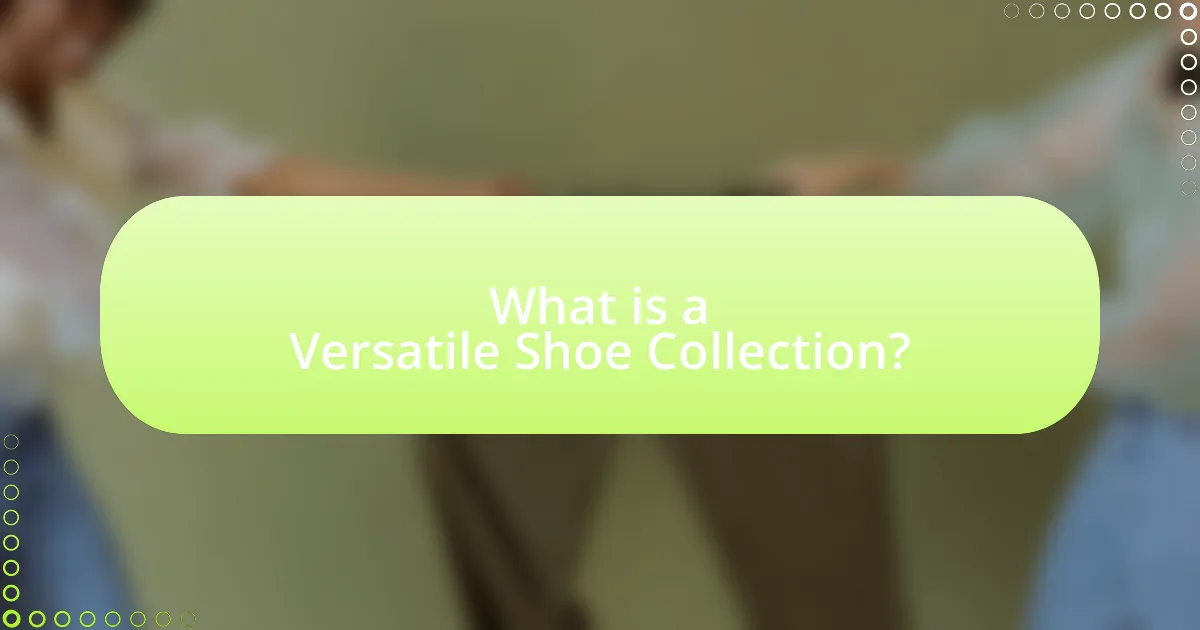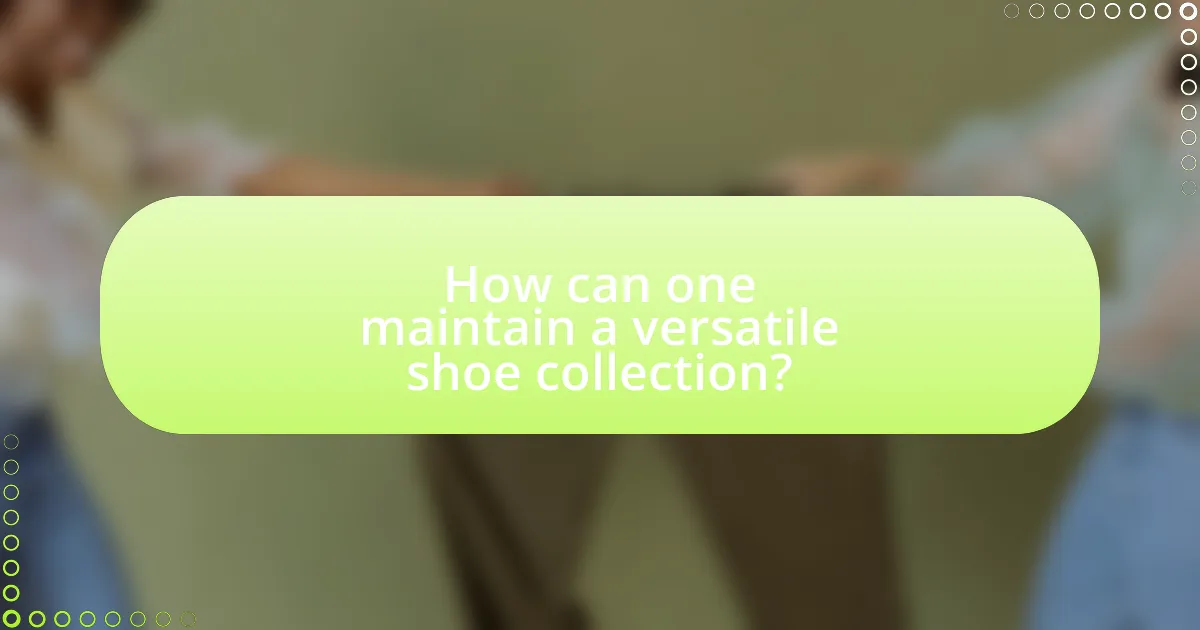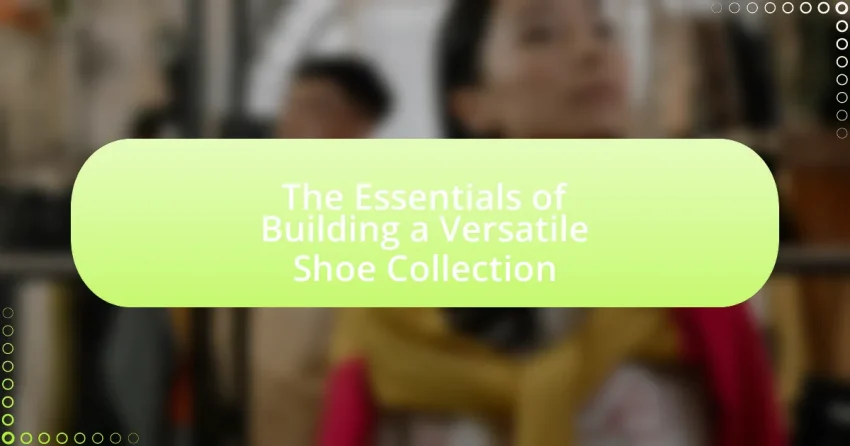The article focuses on the essentials of building a versatile shoe collection, emphasizing the importance of having a range of footwear suitable for various occasions and outfits. It outlines key characteristics of versatile shoes, such as adaptability, comfort, and durability, while detailing essential categories including sneakers, dress shoes, sandals, and boots. The article also discusses strategies for assessing and maintaining a shoe collection, identifying gaps, and prioritizing purchases based on lifestyle needs and budget. Additionally, it highlights the role of accessories and color coordination in enhancing the versatility of a shoe collection, while cautioning against common mistakes like impulse buying and trend-focused purchases.

What is a Versatile Shoe Collection?
A versatile shoe collection consists of a range of footwear that can be worn for various occasions and outfits. This type of collection typically includes essential styles such as casual sneakers, formal dress shoes, comfortable sandals, and versatile boots, allowing individuals to adapt their footwear to different settings, from casual outings to formal events. The concept of versatility in a shoe collection is supported by fashion experts who emphasize the importance of having foundational pieces that can be mixed and matched, thereby maximizing the utility and style of one’s wardrobe.
Why is it important to have a versatile shoe collection?
A versatile shoe collection is important because it allows individuals to adapt their footwear to various occasions and activities. This adaptability enhances comfort, style, and functionality, ensuring that one is appropriately dressed for casual outings, formal events, or athletic pursuits. For instance, research indicates that wearing suitable shoes can significantly impact posture and reduce the risk of foot-related injuries, highlighting the necessity of having options that cater to different needs. Furthermore, a diverse shoe collection can improve overall wardrobe coordination, as different styles can complement various outfits, thereby maximizing the utility of one’s clothing.
What are the key characteristics of versatile shoes?
Versatile shoes are characterized by their adaptability to various occasions and styles. They typically feature a neutral color palette, allowing them to complement a wide range of outfits. Additionally, versatile shoes often have a comfortable design, enabling prolonged wear without discomfort. The materials used are usually durable yet stylish, ensuring longevity while maintaining an appealing aesthetic. Furthermore, versatile shoes often include a balance of formality, making them suitable for both casual and semi-formal settings. These characteristics make them essential for a well-rounded shoe collection.
How does a versatile shoe collection enhance personal style?
A versatile shoe collection enhances personal style by providing options that complement various outfits and occasions. This adaptability allows individuals to express their unique fashion sense, whether dressing for casual outings, formal events, or professional settings. Research indicates that having a diverse range of footwear can significantly impact perceived style and confidence, as different shoes can alter the overall aesthetic of an outfit. For instance, a study published in the Journal of Fashion Marketing and Management found that consumers often associate specific shoe types with particular social identities, reinforcing the idea that footwear choices play a crucial role in personal branding and style expression.
What types of shoes should be included in a versatile collection?
A versatile shoe collection should include the following types of shoes: classic sneakers, formal dress shoes, casual loafers, ankle boots, sandals, and versatile flats. Classic sneakers provide comfort and style for casual outings, while formal dress shoes are essential for professional and formal events. Casual loafers offer a relaxed yet polished look, and ankle boots can transition from day to night effortlessly. Sandals are ideal for warmer weather, and versatile flats can be dressed up or down, making them suitable for various occasions. Each type serves a specific purpose, ensuring that the collection meets diverse needs and occasions.
What are the essential categories of shoes for versatility?
The essential categories of shoes for versatility include sneakers, dress shoes, sandals, boots, and loafers. Sneakers provide comfort and can be styled for casual or sporty looks, making them suitable for various occasions. Dress shoes, such as oxfords or brogues, are necessary for formal events and professional settings, offering a polished appearance. Sandals are ideal for warm weather and casual outings, providing breathability and ease. Boots, including ankle and knee-high styles, offer durability and can transition from casual to semi-formal settings. Loafers combine comfort and style, making them versatile for both work and leisure. Each category serves distinct purposes while allowing for a range of styling options, ensuring a well-rounded shoe collection.
How do different shoe styles serve various occasions?
Different shoe styles serve various occasions by providing appropriate aesthetics, comfort, and functionality tailored to specific settings. For instance, formal shoes like oxfords or loafers are designed for business meetings and formal events, offering a polished appearance and support for prolonged wear. Casual shoes, such as sneakers or loafers, are suitable for everyday activities and social gatherings, prioritizing comfort and ease of movement. Athletic shoes are specifically engineered for sports and physical activities, featuring cushioning and support to enhance performance. Sandals and flip-flops are ideal for warm weather and casual outings, providing breathability and convenience. Each shoe style is crafted with materials and designs that align with the demands of the occasion, ensuring both style and practicality.
How can one assess their current shoe collection?
To assess a current shoe collection, one should categorize the shoes based on type, frequency of use, and condition. This method allows for a clear overview of what is owned and how often each pair is worn, which is essential for determining necessity and potential gaps in the collection. For instance, categorizing shoes into categories such as casual, formal, athletic, and seasonal helps identify redundancies or underutilized pairs. Additionally, evaluating the condition of each shoe—considering factors like wear and tear—can inform decisions about repairs or replacements. This systematic approach ensures that the collection remains functional and aligned with personal style needs.
What criteria should be used to evaluate existing shoes?
To evaluate existing shoes, criteria such as comfort, fit, durability, style, and purpose should be used. Comfort is essential as it affects wearability; shoes should provide adequate support and cushioning. Fit is crucial, as improperly fitting shoes can lead to discomfort and foot problems. Durability indicates the shoe’s lifespan and ability to withstand wear, which is important for cost-effectiveness. Style reflects personal taste and versatility, ensuring the shoes can be worn for various occasions. Lastly, purpose relates to the specific activities the shoes are designed for, such as running, casual wear, or formal events, ensuring they meet the intended use effectively.
How can one identify gaps in their shoe collection?
To identify gaps in a shoe collection, one should first assess the variety of styles, purposes, and occasions represented in their current inventory. This involves categorizing shoes into types such as casual, formal, athletic, and seasonal. By comparing the existing collection against a checklist of essential shoe types, individuals can pinpoint missing categories. For instance, a versatile collection typically includes sneakers, dress shoes, boots, sandals, and loafers. Research indicates that a well-rounded shoe collection enhances functionality and style, making it easier to dress appropriately for various events. Therefore, recognizing the absence of specific types, such as a formal pair or a comfortable sneaker, highlights the gaps that need to be filled for a more comprehensive collection.
What are the best practices for building a versatile shoe collection?
To build a versatile shoe collection, prioritize acquiring a variety of styles that cater to different occasions and outfits. Essential categories include casual sneakers for everyday wear, formal shoes for business or events, boots for colder weather, and sandals for summer. This diversity ensures that you have appropriate footwear for various settings, enhancing your overall wardrobe functionality.
Research indicates that a well-rounded shoe collection can improve personal style and confidence, as noted in a study by the Fashion Institute of Technology, which found that individuals with diverse footwear options reported higher satisfaction with their overall appearance. By focusing on quality over quantity, selecting timeless designs, and considering comfort alongside style, you can create a shoe collection that is both practical and fashionable.
How can one prioritize shoe purchases effectively?
To prioritize shoe purchases effectively, one should assess their lifestyle needs, budget, and existing collection. Evaluating lifestyle needs involves identifying the occasions for which shoes are required, such as work, casual outings, or formal events. Budget considerations help in determining how much can be spent without compromising financial stability. Analyzing the existing collection allows for identifying gaps, ensuring that new purchases complement what is already owned. Research indicates that a well-rounded shoe collection typically includes versatile styles like sneakers, dress shoes, and boots, which can serve multiple purposes, thus maximizing utility and minimizing unnecessary purchases.
What budget considerations should be taken into account?
When building a versatile shoe collection, budget considerations include the total expenditure on footwear, the allocation for different types of shoes, and the potential for long-term investment in quality over quantity. A well-defined budget helps prioritize essential styles, such as casual, formal, and athletic shoes, ensuring a balanced collection. Research indicates that investing in higher-quality shoes can lead to better durability and comfort, ultimately reducing the need for frequent replacements, which can be more cost-effective in the long run.

How can one maintain a versatile shoe collection?
To maintain a versatile shoe collection, one should regularly assess and curate the collection based on lifestyle needs and fashion trends. This involves evaluating the current shoes for versatility, ensuring a mix of styles such as casual, formal, athletic, and seasonal options. Regularly cleaning and properly storing shoes also preserves their condition and longevity, which is essential for maintaining a diverse selection. Research indicates that a well-maintained shoe collection can enhance personal style and functionality, as noted in studies on consumer behavior in fashion.
What are the best ways to care for different types of shoes?
The best ways to care for different types of shoes include cleaning, conditioning, and proper storage tailored to the shoe material. For leather shoes, regular cleaning with a damp cloth and conditioning with leather cream prevents cracking and maintains suppleness. Suede shoes require brushing with a suede brush to remove dirt and using a suede protector spray to repel water and stains. Canvas shoes benefit from machine washing or spot cleaning with mild detergent, while rubber shoes should be wiped down with a damp cloth to remove dirt and prevent odor. Proper storage involves keeping shoes in a cool, dry place and using shoe trees for leather shoes to maintain shape. These methods ensure longevity and maintain the appearance of various shoe types.
How does proper maintenance extend the life of shoes?
Proper maintenance extends the life of shoes by preventing wear and tear, preserving materials, and enhancing overall durability. Regular cleaning removes dirt and debris that can degrade materials, while conditioning leather prevents cracking and drying. Additionally, proper storage, such as using shoe trees, maintains shape and prevents creasing. Research indicates that shoes maintained with appropriate care can last up to 50% longer than those that are neglected, demonstrating the significant impact of maintenance on longevity.
What cleaning methods are recommended for various materials?
Cleaning methods vary based on the material of the shoes. For leather, a damp cloth followed by a leather conditioner is recommended to maintain suppleness and prevent cracking. For canvas, a mixture of mild detergent and water applied with a soft brush effectively removes dirt and stains. Suede requires a specialized suede brush to lift dirt without damaging the fibers, while rubber soles can be cleaned with a mixture of baking soda and water for effective stain removal. These methods are supported by industry practices that emphasize material-specific care to prolong the life of footwear.
How can one adapt their shoe collection for seasonal changes?
To adapt a shoe collection for seasonal changes, one should categorize shoes based on the climate and activities typical of each season. For instance, during winter, prioritize waterproof boots and insulated footwear to combat cold and wet conditions, while in summer, focus on breathable sandals and lightweight sneakers. This approach ensures that the collection remains functional and suitable for varying weather conditions. Additionally, rotating shoes based on the season helps maintain their condition and longevity, as shoes are designed for specific environments. Research indicates that proper shoe care and seasonal rotation can extend the lifespan of footwear by up to 30%.
What strategies can be employed to rotate shoes seasonally?
To rotate shoes seasonally, individuals can implement a systematic approach that includes categorizing shoes by season, maintaining a rotation schedule, and ensuring proper storage conditions. Categorizing shoes involves grouping them into seasonal categories such as summer, winter, and transitional footwear, which allows for easy identification of appropriate options for the current weather. Maintaining a rotation schedule ensures that shoes are worn evenly, preventing excessive wear on any single pair; for example, wearing different pairs each week can extend their lifespan. Proper storage conditions, such as keeping shoes in a cool, dry place and using shoe trees or boxes, help preserve their shape and materials, further enhancing their longevity and usability across seasons.
How can one store shoes to maximize longevity and accessibility?
To maximize longevity and accessibility, one should store shoes in a cool, dry place, ideally in their original boxes or clear containers to protect them from dust and moisture. Storing shoes upright, using shoe trees or stuffing them with paper, helps maintain their shape and prevents creasing. Additionally, organizing shoes by frequency of use or type enhances accessibility, allowing for easy retrieval. Research indicates that proper storage can extend the lifespan of shoes by preventing damage from environmental factors and maintaining structural integrity.

What tips can enhance the versatility of a shoe collection?
To enhance the versatility of a shoe collection, focus on selecting a variety of styles that can be worn for different occasions. Incorporating essential types such as casual sneakers, formal dress shoes, versatile ankle boots, and comfortable sandals allows for adaptability across various settings. For instance, a classic pair of black dress shoes can transition from office wear to formal events, while neutral-colored sneakers can complement both casual and semi-formal outfits. Additionally, choosing shoes in neutral colors increases compatibility with a wider range of clothing, making it easier to mix and match. This approach is supported by fashion experts who emphasize the importance of a well-rounded shoe collection for maximizing outfit options.
How can accessories complement a versatile shoe collection?
Accessories can enhance a versatile shoe collection by providing additional styling options and versatility for various occasions. For instance, items like belts, bags, and jewelry can transform the look of a single pair of shoes, allowing them to be worn in different contexts, such as casual, formal, or professional settings. Research indicates that accessorizing can increase the perceived value of an outfit, making it more visually appealing and cohesive. This adaptability is crucial for maximizing the utility of a shoe collection, as it allows individuals to create multiple outfits with fewer pairs of shoes.
What types of accessories work best with various shoe styles?
Different types of accessories complement various shoe styles effectively. For instance, sneakers pair well with casual accessories like backpacks and baseball caps, enhancing a laid-back look. Dress shoes, on the other hand, are best matched with formal accessories such as leather belts and wristwatches, which elevate the overall sophistication. Ankle boots can be styled with scarves and statement jewelry, adding a trendy touch to outfits. Sandals work well with lightweight bags and beach hats, perfect for summer outings. Each accessory type enhances the shoe style’s aesthetic, creating a cohesive appearance.
How can one use color coordination to enhance versatility?
Color coordination enhances versatility by allowing individuals to create a cohesive and adaptable wardrobe. By selecting a color palette that includes neutral tones, such as black, white, gray, and beige, alongside a few accent colors, one can mix and match shoes with various outfits effortlessly. This approach enables the integration of different styles and occasions, ensuring that shoes can be worn across multiple settings, from casual to formal. Studies in fashion psychology indicate that cohesive color schemes can improve the perceived harmony of an outfit, making it more visually appealing and versatile.
What common mistakes should be avoided when building a shoe collection?
Common mistakes to avoid when building a shoe collection include purchasing shoes solely based on trends rather than personal style, neglecting to consider comfort and fit, and failing to diversify the types of shoes in the collection. Relying on trends can lead to a collection that quickly becomes outdated, while prioritizing comfort ensures that the shoes are wearable and practical. Additionally, a lack of variety, such as not including casual, formal, and athletic options, can limit the versatility of the collection. According to a study by the Fashion Institute of Technology, a well-rounded shoe collection enhances overall wardrobe functionality and personal expression.
How can impulse buying affect the versatility of a collection?
Impulse buying can limit the versatility of a collection by introducing items that do not complement existing pieces. When consumers make spontaneous purchases, they often prioritize immediate gratification over thoughtful selection, leading to a collection that lacks cohesion. For example, a study published in the Journal of Consumer Research found that impulse purchases are frequently driven by emotional responses rather than practical needs, resulting in mismatched items that do not enhance the overall functionality of a collection. This lack of alignment can hinder the ability to create diverse outfits, ultimately reducing the collection’s effectiveness in serving various occasions.
What are the pitfalls of focusing too much on trends?
Focusing too much on trends can lead to a lack of individuality and poor investment in footwear. When consumers prioritize trendy shoes, they often overlook their personal style and comfort, resulting in a collection that lacks versatility. Additionally, trends can be fleeting; for instance, a study by the Fashion Institute of Technology found that 80% of fashion trends last less than two years, which can lead to wasted money on shoes that quickly go out of style. This approach can also contribute to unsustainable consumption patterns, as the fast fashion industry encourages frequent purchases of low-quality items, ultimately harming both the environment and the consumer’s wallet.
What practical tips can help in curating a versatile shoe collection?
To curate a versatile shoe collection, prioritize selecting a range of styles that cater to different occasions and outfits. Start with essential categories such as casual sneakers, formal shoes, boots, and sandals to ensure coverage for various settings. Incorporate neutral colors like black, brown, and white, as these shades easily complement diverse wardrobes. Additionally, consider the quality of materials; investing in well-made shoes enhances durability and comfort, making them suitable for frequent wear. Research indicates that a balanced shoe collection can improve outfit versatility, as noted in fashion studies highlighting the importance of foundational pieces in personal style.
